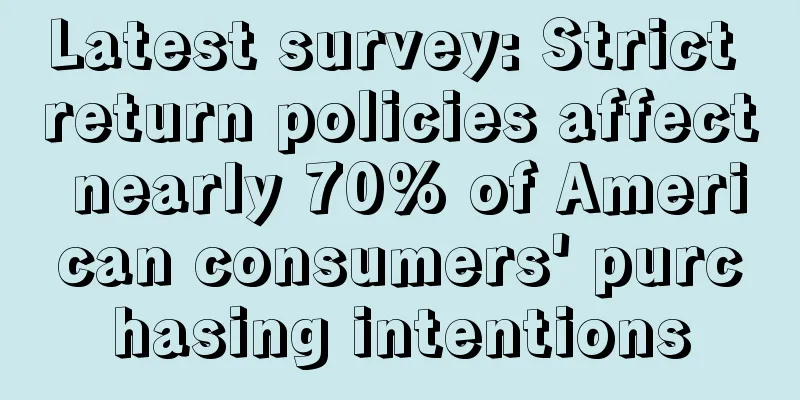Latest survey: Strict return policies affect nearly 70% of American consumers' purchasing intentions

|
It is learned that on September 18, according to foreign media reports, according to Blue Yonder's 2024 Consumer Retail Returns Survey, American consumers' shopping spending has been reduced as retailers try to cut the rising costs of processing product returns and introduce stricter return policies. Data shows that 91% of American consumers believe that loose return policies will affect their purchasing decisions. Among consumers who are aware of stricter return policies, 69% said that these policies hindered their purchases, a significant increase from 59% in 2023. Among them, Generation Z and Millennials are the most affected, with three-quarters of young consumers (76% of Generation Z and 74% of Millennials) saying that stricter return policies hindered their purchases. At the same time, 51% of consumers believe that return restrictions are inconvenient or unfair, while 37% of consumers say these restrictions are fair and understandable. Tim Robinson, vice president of returns at Blue Yonder, said that stricter return policies are beginning to hinder consumers' shopping, especially Generation Z and Millennials. Retailers need to address the cost reduction caused by returns, and the challenge now is to strike a balance between protecting profits and maintaining a good return experience for customers. In terms of return frequency, 56% of consumers only return products once or twice a year or less, 22% return products every few months, 6% return products every month, and only 10% say they have never returned products. Among consumers who have never returned products, Generation Z accounts for 39%, followed by Generation X (27%), Millennials (22%) and Baby Boomers (13%). As for the reasons for returns, 75% of consumers said that it was mainly because of the wrong size, in addition to damaged products (68%), changing their minds or not liking the product (49%), and receiving the wrong product (47%). The survey shows that one way retailers are meeting the ongoing demand for returns is by deploying third-party return services (such as drop-off points or mail-in services). When asked what factors would prompt them to use a third-party return service, 62% of consumers chose lower or free shipping, 60% chose convenient drop-off points, 47% chose fast refund processing, 39% chose the ability to guarantee a worry-free return, and 38% mentioned the ability to reliably track and confirm the return process. Robinson said that if retailers' goal is to reduce return costs, they should focus on reducing return rates rather than simply tightening return policies. For example, by collecting data and making intelligent decisions, retailers can reduce the cost of each return and improve transportation efficiency without affecting the customer experience. In addition, data can help retailers understand which products are returned, which customer groups frequently return products, and the specific reasons for returns, so that they can take appropriate measures. Author ✎ Rayna/ Statement: This article is copyrighted and may not be reproduced without permission. If you need authorization, please contact: happy |
<<: Bain predicts: Non-store sales will drive 90% of U.S. holiday season growth
Recommend
What are Social Sharing Buttons? Social Sharing Buttons Review
Social Sharing Buttons, as the name suggests, is a...
What is Premier League Overseas Shopping? Premier League Overseas Shopping Review
Yingchao Haitao is a cross-border e-commerce brand...
What are Amazon canonical links?
What are Amazon canonical links? Canonical URL: A...
What is Priority Mail Express? Priority Mail Express Review
Priority Mail Express offers next-day to 2-day del...
What is AUTOMAN Intellectual Property? AUTOMAN Intellectual Property Review
Shenzhen AUTOMAN Intellectual Property Co., Ltd. (...
What is AutoBot? AutoBot Review
Founded in 2015 by former Alibaba and Oracle emplo...
Can anyone participate in the Primeday flash sale for free? !
The main activity of Primeday is the LD flash sal...
The factory transformed into Amazon, but I was forced to work for half a year for nothing
Preface of the Little Clone: This week’s seller s...
Online shopping becomes a habit! US consumers' online spending will increase in 2021!
According to a survey by B2B review company Clutch...
What is Iconosquare? Iconosquare Review
IconoSquare is a powerful Instagram and Facebook a...
What is US company registration? US company registration review
Registering a US company can be said to be the fas...
Adding fuel to the fire! Amazon has two more bad news!
Earlier this month, Amazon’s new warehousing confi...
What is QID? QID Review
QID is a Unix timestamp, which refers to the numbe...
What is Yiguo Technology? Yiguo Technology Review
Yiguo (Shenzhen) Technology Co., Ltd. was establis...
What is Sessionbox? Sessionbox Review
SessionBox is a Google Chrome plug-in that allows ...









